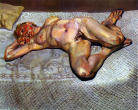|
AMERICAN REAL (excerpt of review)
MATTHIASDOTTIR has been inventing subtly angled compositions for a quarter century and more, and by now she's pushed beyond plane geometry into the mysterious laws of physics. In her recent paintings, a small glass jar set way off to the side is dense, heavy, magnetically charged, while an eggplant or a melon that's right up front has a weightlessness that defies its mass. MATTHIASDOTTIR has stripped away still life's allegorical and metaphorical meanings. She's gone back to the basics, which turn out to be startlingly complicated and unpredictable. The objects control the space. And we're exhilarated, because everything seems to be coming together right before our eyes. . . HANS HOFMANN, with whom MATTHIASDOTTIR studied after she arrived from Iceland in the early 1940s, always structured his teaching around the experience of working from a still life or a nude. He certainly encouraged Abstract Expressionists such as JOAN MITCHELL to bring a strong perceptual element into their work, and the important painters of figures, landscapes and still lifes who studied with HOFMANN include not only MATTHIASDOTTIR, but also NELL BLAINE and ROBERT De NIRO (the father of the actor). It's sometimes forgotten that GIACOMETTI's mature representational style was first shown not in Paris but in New York, at the Pierre Matisse Gallery in 1948. And it's also significant, I think, that BALTHUS's first museum retrospective was in 1956 at the Museum of Modern Art, where it ran concurrently with a POLLOCK show. New Yorkers have always had their romantically speculative streak, which led them to abstract art; but they're also pragmatists who believe that what you see is what you get. After a decade when everybody has been looking for alternatives to the less- is-more approach of much New York School abstraction, you'd expect that attention would focus on all the other painting that goes on in New York. There has been some revisionist thinking, but it hasn't really amounted to much. People grow weary of the old myths, but they cling to them, too, and when the time comes for a change, there's a tendency just to pile new myths on top of old. This helps to explain why, with abstract painting losing its allure, American museumgoers who want to get back to nature have been inclined to embrace the School of London, which is presented as a realist alternative to New York. In 1994, LUCIAN FREUD's retrospective at the Metropolitan Museum became dinner party conversation all over Manhattan. FREUD's high bohemian London, with aristocratic ladies and a drag queen all undressing in the artist's barren atelier, had a hardbitten documentary impact. And New York succumbed.
The MATTHIASDOTTIR retrospective ought to be recognized as a key event in contemporary art. It ought to be at the Metropolitan Museum, where LUCIAN FRUED had his show. But that won't happen, since this artist's major-league emotional impact is so unlike what people have been led to expect from important new painting, especially in New York. MATTHIASDOTTIR doesn't care to startle us with the very fact of her being a realist. She insists on an old idea of visual credibility, but she gives that approach an uncategorizable contemporary freedom, and she does so with a feeling for color and construction that come straight out of abstract art. She's a New York School painter who wants to celebrate the overwhelming reality of the city; her still lifes have a New York clarity, a New York pace. Her work is such a thoroughgoing synthesis that it may be misunderstood as cautiously conventional. But if you tune into what MATTHIASDOTTIR is doing, you may end up thinking that if this isn't part of the mainstream, then the mainstream can go to hell
Source: Jed Perl on Art
|

